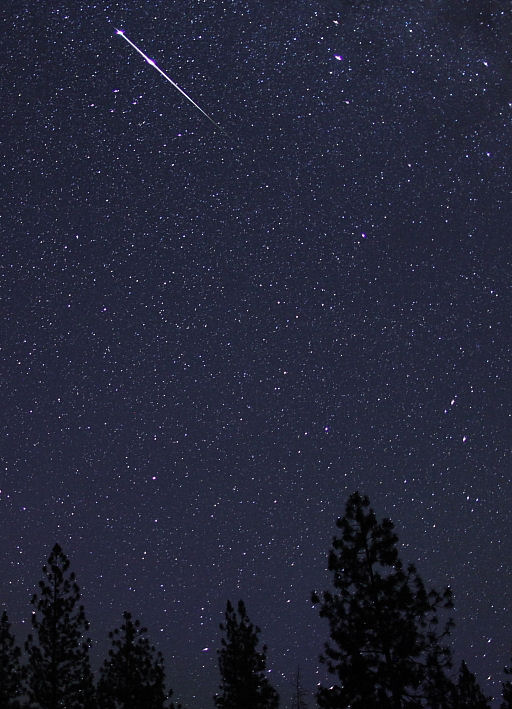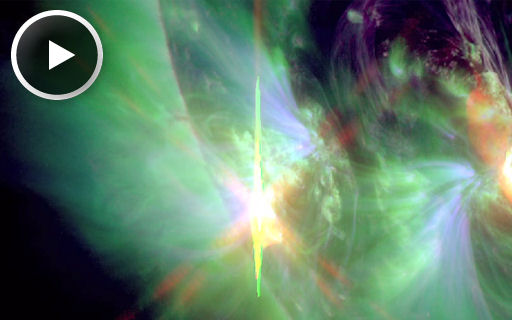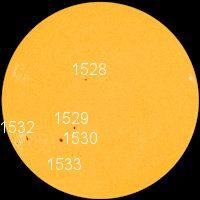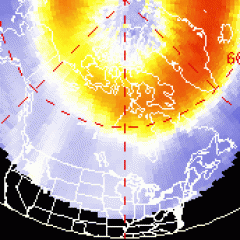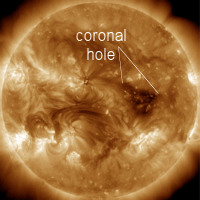MARS LANDING SKY SHOW: On the same night Curiosity lands on Mars, a "Martian Triangle" will appear in sunset skies of Earth. The first-magnitude apparition on August 5th gives space fans something to do while they wait for news from the Red Planet. [video]
DELTA AQUARID METEOR SHOWER: This weekend, Earth is passing through a stream of debris from Comet 96P/Machholz, source of the annual delta Aquarid meteor shower. Forecasters expect as many as 15 meteors per hour when the shower peaks on July 28-29. The location of the shower's radiant below the celestial equator favors southern hemisphere observers. Nevertheless, northerners can see it too. For instance, David Hoffmann caught this early delta Aquarid flashing over Ashland, Oregon, on July 24th:
"A movie of the meteor may be found on my Youtube page," says Hoffman.
Although this is a minor shower, it is fraught with interest. Some researchers believe that the delta Aquarids' parent comet, 96P/Machholz, came from another star system. Every delta Aquarid that disintegrates in the night sky could be depositing material from across the galaxy into Earth's upper atmosphere.
The best time to look, no matter where you live, is during the dark hours before sunrise on Saturday and Sunday when the moon has set and the constellation Aquarius is relatively high in the sky. Got clouds? Try listening to delta Aquarid radar echoes on Space Weather Radio.
M-CLASS FLARE: Newly-emerging sunspot AR1532 unleashed an M2.7-class solar flare on July 27th at approximately 1726 UT. NASA's Solar Dynamics Observatory captured the extreme ultraviolet flash:
The explosion does not appear to have produced a substantial CME. Even if it did, Earth is not in the line of fire. This sunspot will, however, become more geoeffective in the days ahead as it slowly turns toward Earth. Stay tuned for updates. Solar flare alerts: text, voice.

![]()
Solar wind
speed: 300.3 km/sec
density: 0.1 protons/cm3
explanation | more data
Updated: Today at 1656 UT
![]()
X-ray Solar Flares
6-hr max: C1 1319 UT Jul28
24-hr: C1 0730 UT Jul28
explanation | more data
Updated: Today at: 1600 UT
![]()
![]()
![]()
Daily Sun: 28 Jul 12
![]()
![]()
Sunspot AR1532 poses a growing threat for M-class solar flares. Credit: SDO/HMI
![]()
![]()
![]()
Sunspot number: 91
What is the sunspot number?
Updated 28 Jul 2012
Spotless Days
Current Stretch: 0 days
2012 total: 0 days (0%)
2011 total: 2 days (<1%)
2010 total: 51 days (14%)
2009 total: 260 days (71%)
Since 2004: 821 days
Typical Solar Min: 486 days
Updated 28 Jul 2012
The Radio Sun
10.7 cm flux: 123 sfu
explanation | more data
Updated 28 Jul 2012
![]()
![]()
![]()
Current Auroral Oval:
![]()
Switch to: Europe, USA, New Zealand, Antarctica
Credit: NOAA/POES
![]()
![]()
![]()
Planetary K-index
Now: Kp= 3 quiet
24-hr max: Kp= 3 quiet
explanation | more data
![]()
Interplanetary Mag. Field
Btotal: 8.6 nT
Bz: 7.3 nT south
explanation | more data
Updated: Today at 1656 UT
![]()
![]()
![]()
Coronal Holes: 28 Jul 12
![]()
![]()
A solar wind stream flowing from this coronal hole should reach Earth on July 29-30. Credit: SDO/AIA.

